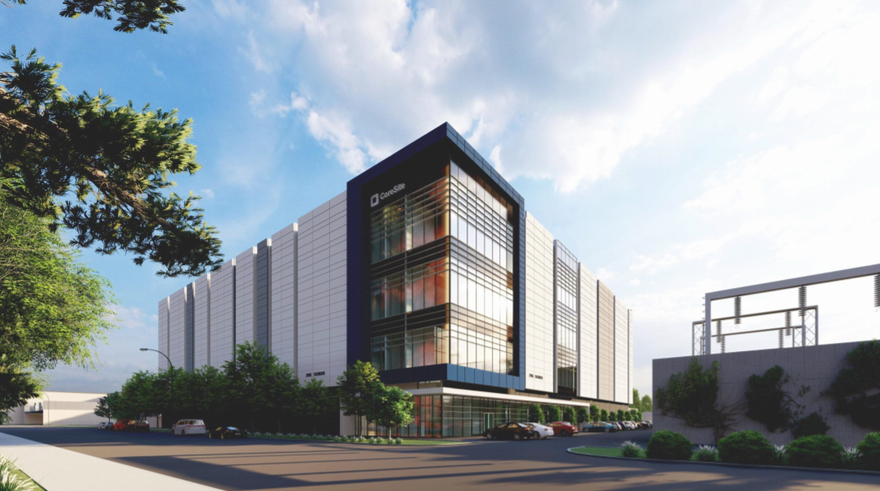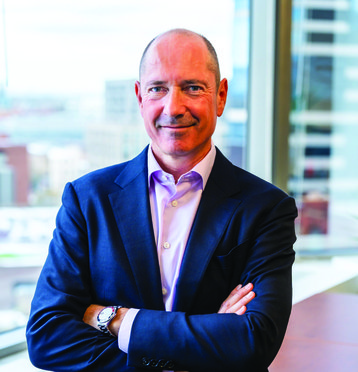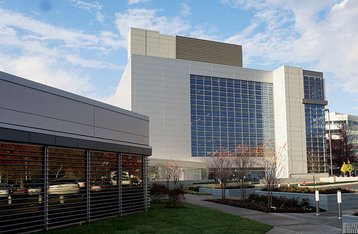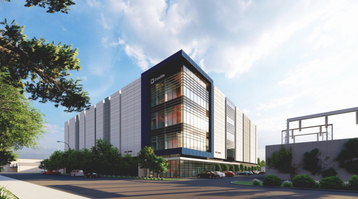Juan Font can get hands-on with his company’s equipment any time he wants. His office is in CoreSite’s VA 3 data center, on the company’s Reston, Virginia, campus.
“I love to listen to the servers every day,” he tells me over the phone. “From where I sit, it would take me probably 30 seconds to get to the computers.”
This keeps him close to the business, he says, “I do a walkabout each day, to understand how our customers are utilizing the platform. “I help them to work and I just love to get dirty, to get into the nitty-gritty.”
Starting in an icon
US colocation specialist CoreSite began life in 2001 at One Wilshire, an iconic carrier hotel in Los Angeles. The building’s owner, Carlyle Group, set up a subsidiary, CRG West, to manage interconnectivity at One Wilshire, as well as the Market Post Tower (now Tower 55) in San Jose, which at that time hosted one of the Internet’s oldest exchange points, MAE West.
Through the first years of the 21st century, CRG expanded into Washington, Boston, and Chicago, before changing its name to CoreSite and floating in a 2010 IPO. The Denver office came later when CoreSite bought ComFluent in 2012.
“I joined here in September 2010, and that was about a month and a half before we went public,” says Font. “I’ve been here through that journey - becoming a public company and being independently operated from 2010 through 2021, before being acquired by American Tower.”
Font was previously at data center giant Equinix: “So I’ve been in the data center industry since 2005,” he says.
Before that, he was in telecoms, at Teleglobe and Aleron Broadband. “I was negotiating with telecom carriers and PTTs,” he recalls. “But since that market became more liberalized, there's been more competition. I don't know if you recall the days when calling international would be like $2 a minute - but those rates started to drop dramatically.”
With the Internet and IP supplanting the core of voice networks, he says: “There were a lot of bankruptcies, and returns were always declining over time. It became very difficult to make a living in that space.”
When he joined data centers, he immediately felt the contrast: “What a wonderful business,” he says. “We were at the dawn of the digital age with unending growth. I thought it was a great career move. I don't think you had to be particularly brilliant to succeed in this business”
Is he being modest? “It's a demand-driven business. You don't need to generate demand. The amount of data that gets created, processed, transmitted, and stored, continues to grow at an unbelievable rate - and every X number of years, you have this next, paradigm-shifting phenomenon that upends everything and accelerates it. From that perspective, it seems like it's very hard to fail.”
First impressions
When he first saw inside a data center, he noticed several things: “It wasn’t like today,” Font says. “They were very small assets. The rooms were hot and noisy.”
More importantly, he saw a “sticky” business model: “Once you see a cabinet with all these cables running around, you understand that each cable is going to a separate customer, and you know, this business is pretty sticky. Because for that network or enterprise to move somewhere else, you have to migrate all those connections.”
He also saw an industry that was capital-intensive: “Particularly for the smaller companies, to keep adding Inventory and power distribution, the capital intensity is very high compared to other models. On the network side, fiber is expensive, but it's nothing like building these buildings and adding all this electrical and mechanical infrastructure.”
Finally, he understood location: “Once you realize how sticky the business was, you know locations are not created equal,” Font explains. “You can be in one building, but being in this suite is so much better than the other suite because the peering is changed, for example. I learned the value of interconnection, fairly early on.”
He saw all this at Equinix, but wasn’t quite comfortable there: “Equinix is the incumbent, the largest, most dominant interconnection-driven platform out there,” he says. “But I love the underdog.”
He says Equinix became “almost like a monopoly telecom operator” that could “treat customers like subscribers, and I like to create bonds and relationships with customers.”
He also observed that Equinix’s retail focus meant that it missed out on the opportunities for wholesale colocation provision. These were being picked up by other players, he says.
“Equinix was very retail oriented, and there were emerging platforms out there like DuPont Fabros, Digital Realty Trust, and CoreSite, that could also sell wholesale,” he says. “That felt attractive, being able to do different types of deals, not just working with networks and other digital platforms, but also with enterprises.”
Combining connection and capacity
So he looked elsewhere: “What attracted me about CoreSite was, it was a much smaller company, and still is - so as an individual contributor, the ability to be more impactful was very meaningful to me. Also they owned One Wilshire, the preeminent carrier hotel on the West Coast, the most integrated building, and the second most important peering platform in the US.”
The company could operate in different markets: This is a company that has cut its teeth with interconnection, which is where I come from, but at the same time, it is investing in these very large buildings and is going toe to toe against competitors in the wholesale space.”
This was before there was a hyperscale market, he says: “We called it wholesale.” And he wanted to do that as well as interconnection.
“We were very early in wholesale, and other younger companies never really adapted,” he explains. “When I joined, our business model was around owning and operating carrier hotels. We quickly realized that the advent of the digital age, social media, and search required heavier racks and more power.
That was different from the carrier hotels business: “Carrier hotels were well suited for enabling interconnection between carriers,” he says. “You would go to a central location, like One Wilshire, and all the carriers from Asia Pacific would converge and exchange traffic with each other, whether it was voice traffic or data traffic. They were very well suited for interconnection with a very large meet-me room.”
Companies like Google, Facebook, and (at the time) MySpace were different: “They required larger spaces, and much more power.”
CoreSite developed a campus model: “LA2 was probably the first manifestation. It was the old Post Office annex in Los Angeles, at 900 N Alameda, and we tethered it to One Wilshire with high-count dark fiber that we owned.”
Developments like that were able to offer larger footprints to customers, but also access strong interconnection: “That was something that CoreSite had really thought about. Equinix was still fairly focused on smaller retail transactions expanding globally, while competitors like Digital and DuPont were more focused on just the larger stuff. But we were able to do both. We were able to provide large footprints that were tethered to an extremely rich network ecosystem.”
After that, a new kind of player emerged: the cloud provider. “It all started with Amazon, here in Northern Virginia,” Font says. “But that was a new infrastructure, a new utility that was being built from scratch, which is the cloud. That just took off, and pretty quickly those cloud providers realized that, just like network carrier peering, you have to establish on-ramps for enterprises and other digital businesses to connect to you.”
This is best provided by providers like Equinix or CoreSite, he says: “Those on-ramps became the third leg of the stool, and we pivoted to being a company that could support network to enterprise, enterprise to cloud, and network to cloud.”
As he adds: “With networks and cloud providers, and capacity that was adjacent to it, you can address a fairly wide spectrum of use cases, that are sensitive to latency and have to have certain adjacency to the client on ramps - but at the same time, the operating characteristics of the wholesale model.
Time to expand with American Tower?
CoreSite now has around 28 data centers covering most of the US, but it is not rushing into expansion abroad.
It is a multi-tenant operator: “We have to cater to all walks of life - it can be an enterprise that has very low density, a network, or a high-performance computing environment. Even before AI, over the last couple of decades, we’ve seen a progressive, unrelenting increase in power density.”
“We have a catalog of solutions already in place for enterprises and other digital platforms. They get a cage or a full suite from CoreSite to host their private cloud. Then they use our interconnection to go to the cloud on-ramps, to move some of those workloads to the cloud.”
Enterprises have a continuum where loads can move back and forth as companies evolve, but AI will add a class of workloads beyond enterprise capabilities.
“We have digital hub status in the best markets,” Font explains. “We’re missing one or two, but in LA, Silicon Valley, Northern Virginia. New York, and Chicago, we are the number one or number two interconnection fabric. And we have a lot of capacity that is adjacent.”
That determines where the best place to spend money is: “From a capital allocation perspective, what provides the highest return on invested capital is to continue growing in those markets, because our customers continue to demand more capacity where we are,” Font says.
Now CoreSite has the backing of American Tower, it has added a couple of markets, like Orlando, but its focus is on getting a return on investment: “It's very hard to say, ‘let's be international,’” Font explains. “There is every intention at some point to go international, but I think there's still plenty of work to do here in the US. Our focus is to continue adding capacity in these very large and vibrant markets.”
After all those years of being an independent provider, what is American Tower like as an owner?
“Frankly, being perfectly honest. It's been a godsend,” he responds. “They allow us to operate independently. And they are also very enthusiastic about our business model, and the possibilities of convergence between our disparate real estate communication assets of data centers and towers.”
With American Tower’s funding, CoreSite’s growth has accelerated, Font says: “It is very net positive for CoreSite to be part of a Fortune 350 company, this gives us more credibility with enterprise users.”
As he explains, enterprise customers moving their IT load out of on-premise data centers will want a solid and reputable partner. “You're going to ask, what is the financial wherewithal of this company because you recognize this is a very capital-intensive industry, and you want to make sure that your operator is not cutting corners or maintenance, and has the ability to continue expanding as you grow.”
Combining towers and facilities
What about the towers, though? Is there a synergy between CoreSite’s data centers and its owner’s mobile infrastructure?
“It's a matter of when and not if,” he replies. “There will be a convergence between wireless and wireline infrastructure. American is the largest operator in the US with something like 43,000 towers. Right now, we're embarking on the rollout of 5G, but after that, there'll be a 6G.”
That will increase bandwidth, he says: “Imagine your phone has 100 times the amount of throughput that you have today. There will be more and more applications that are very intensive in data consumption and compute, that will perform close to the end user.”
Right now, cloud regions are centralized but he sees that changing: ”The content and compute utility that you can tap on has to be closer to the end user and that is the Edge.”
Infrastructure closer to users will improve the user experience, “but it's going to take some time for these killer apps to be realized,” Font argues.
“You don't have to have a containerized data center in every tower, but you can have a cluster of towers where you have a mobile Edge compute site with the capability to operate a more Edge-type exchange, where firms can exchange data in closer proximity to users. “It's not just the latency, it is the cost of transporting that amount of data across the country.”
AI will also persuade users who have given up their on-prem data centers to adopt “near-prem” resources he says. “The AI technology is going to enable a lot more applications for near-prem data centers. Where you have points of sale in stores and restaurants, you can supplant individuals with technology, but for it to work properly. It has to be co-located in close proximity to where the points of sale are.”
AI accelerates outsourcing
He thinks AI is a “paradigm-shifting technology” on par with the Internet or cellphones, but it is coming faster: “What has caught me by surprise is how quickly enterprises are jumping onto the bandwagon and utilizing it.”
The surprise is that enterprises are latching on to something that they cannot build for themselves, and that will change how they consume computing.
Of course, he knows forms of AI have been around for many years, with sites like Netflix and TikTok using algorithms to serve content. But the new wave, Font says, is different: “There were a lot of things happening behind the scenes, but now it has become more ubiquitous and easier to use, for a broader base of use cases,” he says. “And that is only going to accelerate AI massively.”
That requires “massive amounts of infrastructure” that are “orders of magnitude higher than anything we've seen before.” Font says: “It's been a phenomenal driver of data center demand, and we are beneficiaries of that emerging trend.”
That trend also changes how data centers are built: “These GPUs consume a lot of power, and most of this capacity is going to be absorbed by hyperscalers, companies that are building massive facilities catering to a single user, like a Microsoft or someone like that.”
Font remembers that “it used to be 2kW per rack. Nowadays, the average in our portfolio is around 6.5kW. That's a fourfold increase in 15 years. With AI that density goes to 20, 30, 40, 50. It's an order of magnitude change.”
He thinks that new hotspots of AI capacity demanded by enterprises will “turbocharge” the existing model of hybrid cloud. The new hardware demands are tough for data center operators like CoreSite, but completely beyond regular IT managers working in 20-year-old data centers: “It is is going to be impossible on their local infrastructure. It will require massive amounts of capital to retrofit their infrastructure - for something that is not their business. So I think AI will accelerate outsourcing.”
Enterprises will have to place demanding AI-related workloads into shared spaces, where they can on-ramps to reach cloud providers for the actual inferencing. “That's what we're trying to prepare our platform for - and we're seeing early signs that that's how it works.”
So CoreSite will be doing some “retooling” he says: “It does require some custom fitting and some planning for those sort of use cases, as we build new data centers, like we are in Denver or New York.” He’s talking about adding flexibility to provide new cooling quicker than he can right now.
AI changes cooling
CoreSite has supported advanced use cases in the past: “We have done liquid cooling for, say, a university deploying high-performance computing or a government agency, but it's been on a one-off basis.”
Most of CoreSite’s data centers have water circulation, he says. “Even if it's air-cooled, those air-handling units get chilled by water anyway. Air is the mechanism that rejects heat from the server. We can tap those pipes and create a separate environment for a customer.”
That would be a one-off offering, though. “We design our facilities to cater to a broad range of use cases. “If you design with that use case in mind only, you will spend an inordinate amount of capital.”
Higher density makes cooling more crucial, he says, because “losing cooling for a smaller period of time can have catastrophic consequences. To avoid this, CoreSite’s cooling has redundancy: “You have N+1 or N+2. You have more pumps than you need, more chillers than you need, and more CRAHs, in a sealed water loop. The one thing you cannot afford to do at a data center is to lose your cooling.”
Overall, Font says CoreSite achieves PUE (power usage effectiveness) figures between 1.2 and 1.5, averaging at about 1.3. The figure depends partly on customers, so CoreSite runs a YouTube channel explaining issues like blanking panels to them.
It also improves as CoreSite updates equipment in older sites like One Wilshire, replacing fixed-speed air handlers with units that have variable fan speeds. “That enables just in time cooling,” he says. “We are replacing old technology with new, and reducing the PUE in our older sites.”
CoreSite aims to procure renewable energy but again has to work with customers. “In Virginia, we have 100 percent renewable energy, but it's harder to do if you have multiple customers in the facility,” the CEO says. “At the end of the day, the utilities that we work with have their own mandates to keep becoming greener, and we work with them to ensure that they continue marching on that journey.”
And customers that have moved into CoreSite will have a lower footprint than in their old on-premise facilities. “In the early days, One Wilshire had a PUE of two-plus, but enterprises operate at 2.5 or 3.0.”
Happy company
On diversity and hiring, he says his senior leadership team is 45 percent female, and 25 percent from under-represented groups, and “more than half of our staff is on data center operations. About 37 or 40 percent of our data center operators are veterans, and something like 30 percent or 40 percent are under-represented minorities. I think our workforce looks more diverse than the country at large.”
He prefers to make change organically rather than mandating it and is pleased with the results: “You can come in as a tier one security guard, with very limited qualifications and just rise through the ranks. It is very encouraging to see that we can provide an environment for underrepresented minorities to come in at a lower level and then just grow within the company.”
Font writes a letter to every employee who reaches ten years with the company: “I can't tell you how many of those folks started as a security guard. And they still just love being at CoreSite.”
He likes to listen to the servers, but it seems he pays attention to the people as well.
More in North America
-

-
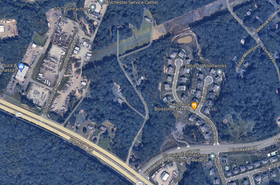
-

Discussion Wake-Up 5k Run & Yoga

